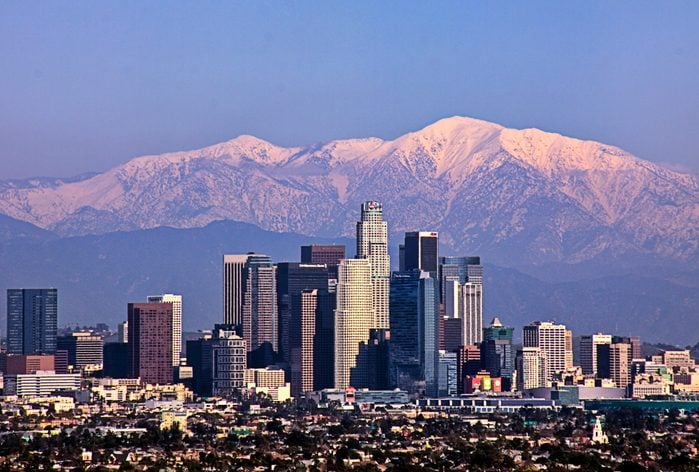
A breather from pollution
Los Angeles, New Delhi, and Beijing have at least one thing in common—they are some of the smoggiest metropolises in the world. With a third of the world in lockdown and economies shuttered for more than a month to prevent the spread of the novel coronavirus, these megacities are experiencing clearer skies for the first time in decades.
On a typical pre-COVID-19 day, emissions from automobiles and factories resulted in heavy smog, obscuring skyscrapers, and historic sites in overpopulated and industrial cities. Air pollution is the cause of millions of deaths yearly around the world. The Clean Air Act, enacted in 1963 and substantially amended in 1970, dramatically improved air quality in the United States within the past 50 years. Prior to the Clean Air Act, noxious fumes from industrial facilities blanketed the country, with toxic air exasperating conditions of asthma and emphysema. Other countries continue to fight the smog with vehicle restrictions and industry regulations.
In honor of Clean Air Month, here’s a look at the smoggiest cities worldwide and how they are faring during the quarantine.
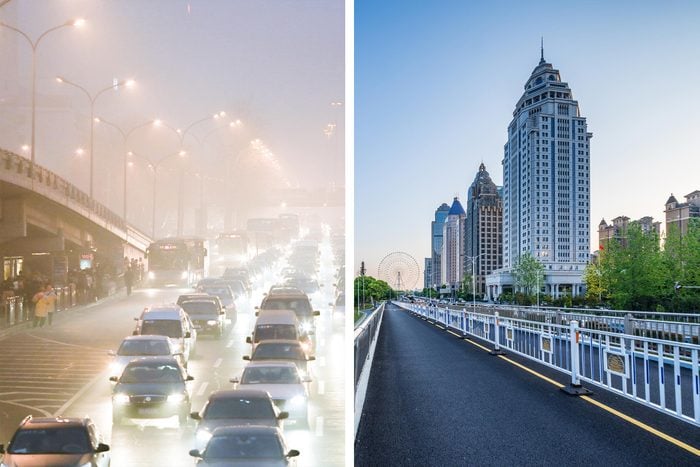
Beijing, China
According to European Space Agency‘s satellite imagery, strict measures and factory closures earlier this year caused a “dramatic reduction in nitrogen dioxide concentrations—those released by power plants, industrial facilities, and vehicles in all major Chinese cities,” bringing clear skies to Beijing. President Xi Jinping’s anti-pollution campaign that began in 2013, with the shuttering of coal-fired plants in Beijing, reduced the levels of PM2.5 (matter that is known to cause cardiovascular and respiratory problems) by more than half. However, pollution still remained a problem in the capital. That is, until the coronavirus pandemic.
“Air quality in Beijing has been amazing; it’s been clear blue skies for weeks,” says David Roye, MD, professor of orthopedic surgery at Columbia University, who arrived in Beijing on February 19 to work at his med-tech startup, JuniperMD, where he serves as the chief medical officer. He’s seen the mountains west of the city on and off during prior visits to China, but he can now see them clearly every morning from his apartment. “In the last 80 days, I had no polluted days in Beijing and it is wonderful being here. I used to only work out at the gym in the hotel, but now I run, walk in the parks, climb in the local parks, so it’s been a totally different experience,” Dr. Roye says. Beijing is also one of the major cities running out of water.
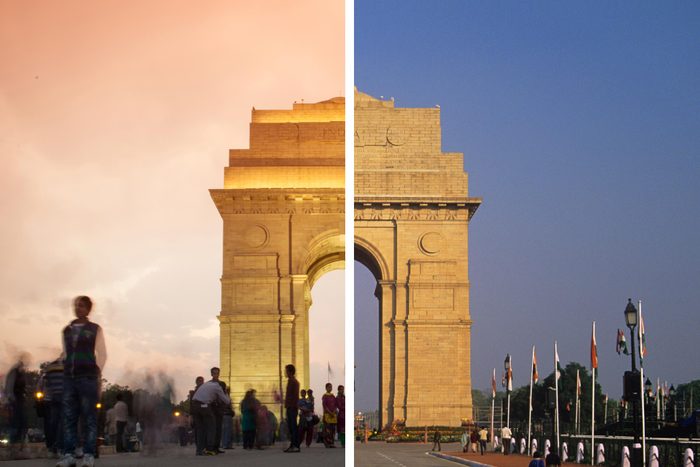
New Delhi, India
The 21 million residents of New Delhi, the world’s most polluted capital, have also been getting a reprieve from the constant smog that fills the air. The sprawling capital of India is experiencing the longest period of clean air on the record and a 60 percent decline in air pollution. The fossil-fueled country, with a population of 1.3 billion, implemented the largest shutdown in the world on March 25 to curb the spread of coronavirus.
In a city where people check the AQI (Air Quality Index) before venturing outside, this is a welcome break. Before the COVID-19 pandemic, pollution from industries, construction, agriculture, and vehicles engulfed the megacity with an unhealthy level of grey smog for months.
“Gone was the familiar menacing red banner, indicating how each intake of breath is really just a toxic blast on the lungs, replaced instead by a healthy, cheerful green,” wrote The Guardian.
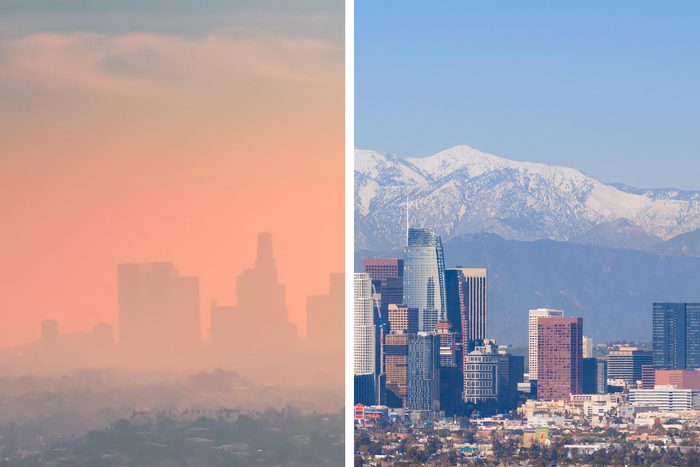
Los Angeles, California, United States
The Southern California metropolis is infamous for its endless traffic and the brown haze that fills the valley, giving the City of Angels the nickname, “Smell-A.” However, Los Angeles enjoyed a long stretch of clean air in March because of a statewide shelter-in-place order. Citing findings from IQAir, a Swiss air quality technology company, CNN reported, “L.A. saw some of the cleanest air of any major city in the world.”
According to CNN, Yifang Zhu, PhD, a professor of Environmental Health Sciences at UCLA’s Fielding School of Public Health, found a “20 percent improvement in overall air quality in Southern California,” from March 16 to April 6. Dr. Zhu’s team also confirmed a 40 percent drop in PM2.5 levels due to a major reduction in traffic.
Residents are rejoicing seeing clear skies. Sandy Stefan, who has lived in Greater Los Angeles for decades, says, “The one time I drove to the west side to see my daughter, it felt like 1978 when I first moved here—no cars and you could see forever.” Theresa Christine, who lives in East Hollywood, says the smog has significantly lessened. “I can see a part of the Hollywood Hills from my patio that I didn’t even know existed before. I’d just never noticed it because the pollution was so bad!”
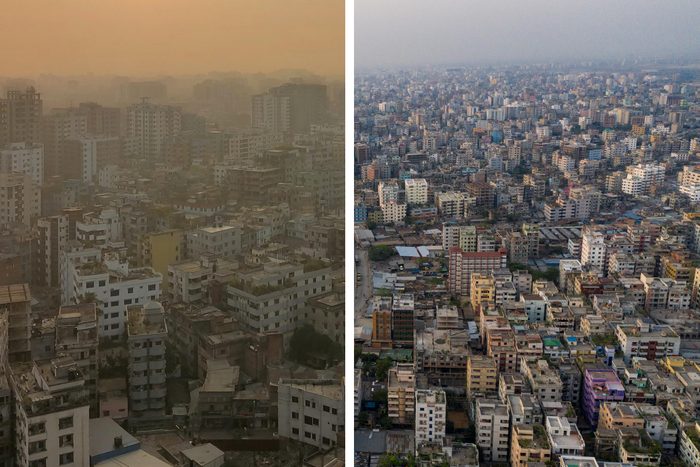
Dhaka, Bangladesh
The capital of Bangladesh is among the most polluted cities in the world, ranking at the top of air IQ Air’s Air Quality Index (AQI) Dhaka’s score is typically in the range of 260 to 319. A score above 150 signifies that air quality has the potential to cause health effects to sensitive groups. On March 29, for a brief moment, the AQI stood at 91, reported the Daily Star. Find out the other most polluted cities in the world.
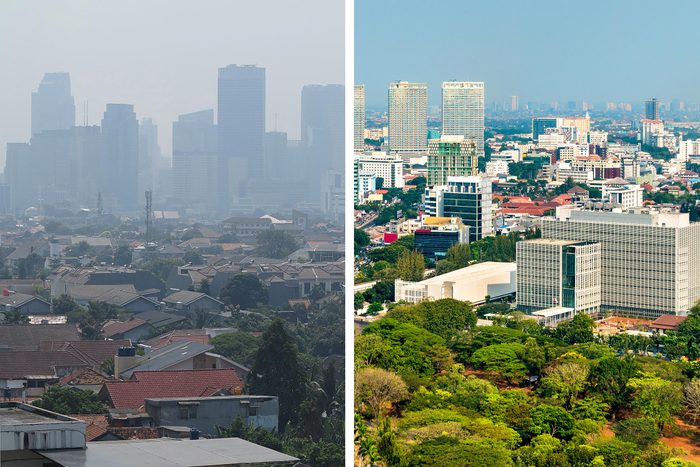
Jakarta, Indonesia
Jakarta ranks among the most heavily polluted cities in the world alongside Delhi and Beijing. It’s so bad, in fact, that last year, a group of local activists tired of breathing harmful air sued the Indonesian government for its lack of action against pollution. Last June, Jakarta registered a 240 AQI score. Residents began posting images of the smog shrouded city with the hashtag #SetorFotoPolusi.
Heavy traffic, coal plants, and waste burning are a few culprits of the city’s increasing pollution problem. According to the Jakarta Post, the Jakarta Environment Agency reported slightly improved air quality after restrictions for coronavirus were put in place in late March and, in fact, as of early May, Jakarta’s AQI has not risen past 150. See what the world’s most polluted beaches used to look like.
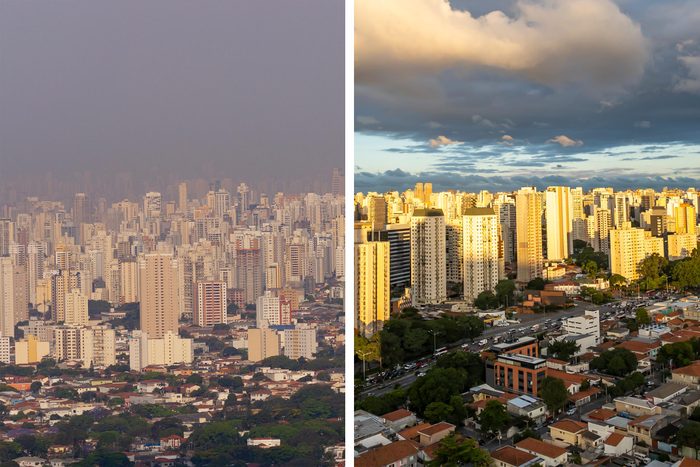
São Paulo, Brazil
South America’s most populous city, São Paulo, endures traffic jams and smoggy conditions. Then as the epicenter of coronavirus cases in Brazil, the city took drastic measures to curtail the spread with a citywide lockdown and is now enjoying the unintended (and much welcome) consequences of cleaner air. Santiago Marrodán, a travel guide in São Paulo, went for a walk for the first time in weeks and couldn’t believe his eyes. “The air is cleaner and the sky is bluer. It didn’t feel real because I was very happy about going outdoors. Pollution probably decreased because there are fewer cars on the street than usual.”
Downtown’s João Goulart Highway, nicknamed Minhocão (the Big Worm) is idyllic in the absence of bumper-to-bumper traffic. According to the COVID-19 Air Quality Report by IQAir, the city experienced a 32 percent reduction in air pollution between March 23 and April 13.
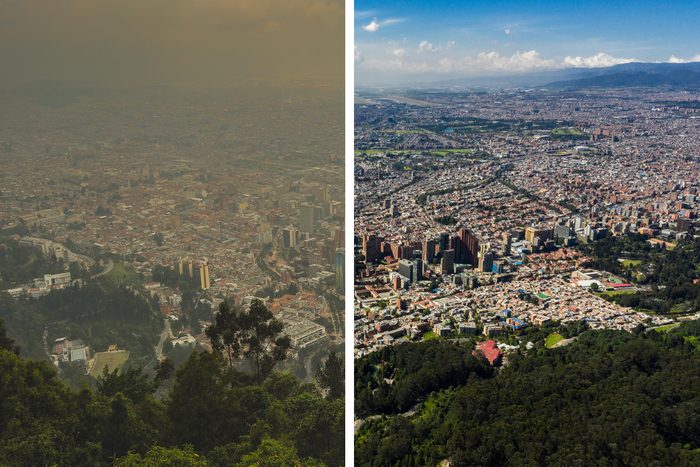
Bogotá, Colombia
Before the COVID-19 outbreak, Bogotá would close its roads to cars on Sundays to control air pollution, encouraging its residents to use bikes and motorbikes instead. The capital of Colombia, located high up in the Andes, went into quarantine on March 24, halting most of the traffic. Since then, there are two noticeable differences, says Nathan Falde, who has been living in the suburbs of Bogotá for the past four years. “The first is the odor. The air in Bogota doesn’t always look polluted, but it usually smells that way. While it isn’t odor-free now, the smells aren’t as strong in most places and there is a bit of freshness to the air that wasn’t there before.”
Secondly, Falde says that he can see into the distance more clearly. “Bogota is nestled in the foothills of the Andes; we’re about 8,600 feet above sea level and there are mountains all around us in all directions. There isn’t nearly as much of a haze now, making the far-off vistas sharper and clearer.” Find out the beautiful places that might disappear in your lifetime.
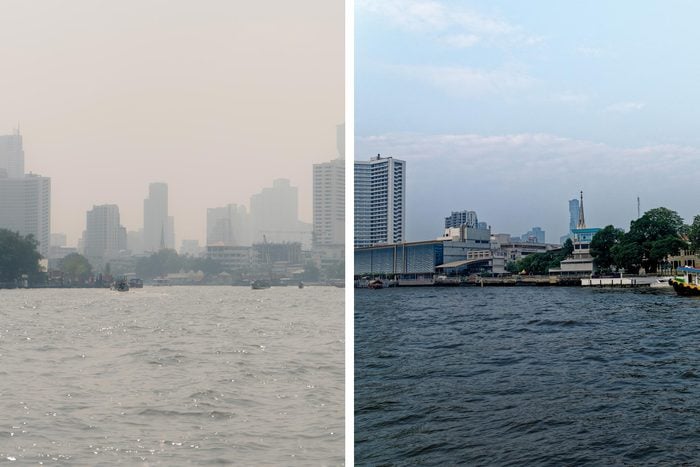
Bangkok, Thailand
School closures aren’t new for Thailand’s capital; in early 2019, Bangkok closed more than 400 schools for a week due to unhealthy air. “The government has tried seeding rain clouds, reducing traffic, and hosing down streets, with little impact,” according to BBC. Now, with the implementation of work-from-home policies, a nightly curfew, and closure of all non-essential businesses, air pollution has decreased a bit. Channel News Asia reported that between March 15 and April 10, the average PM2.5 levels were reduced by 22 percent in parts of the capital city and 15 percent in air monitoring stations in other areas.
Despite the change in pollution levels, some residents aren’t seeing a noticeable difference. “You can really feel the smog in the air: the smell and the allergy-type responses, especially if you have a condition such as asthma,” says Amy Poulton, who has been living in Bangkok for over a year.
A recent report by Coconuts Bangkok attributes a majority of the air pollution, in the absence of normal economic activity, to the agricultural practice of burning fields. Regardless of its pollution woes, Bangkok is traditionally one of the most popular travel destinations in Asia.

Milan, Italy
Italy was the second country to become a victim of widespread COVID-19 cases, which led the government to implement quarantine measures to control the viral spread. In a country where half the cars run on diesel, the lockdown caused a significant decline in pollution. Analysis of data from the European Space Agency’s Sentinel-5P satellite by The Washington Post revealed that concentrations of nitrogen dioxide, a pollutant that is potentially dangerous for those with asthma and inflammation of the lungs, fell dramatically, especially over northern Italy, between January 1 and March 12.
Janna Brancolini, an American journalist based in Milan, lives on a street bookended by major intersections. Prior to the outbreak, noise and car exhaust prevented her from enjoying her balcony. Now, she can hear the birds sing. “One morning about five weeks into the lockdown, I went outside to drink my coffee on the balcony and realized the air smelled like nature—that wonderful earthy smell you encounter in the woods right before it rains.”
Milan has temporarily expanded bike lanes on 22 miles of city streets to reduce the use of public transit. Meanwhile, in Venice, residents are seeing fish and swans in its historic canals—one of the ways nature is rebounding during coronavirus.
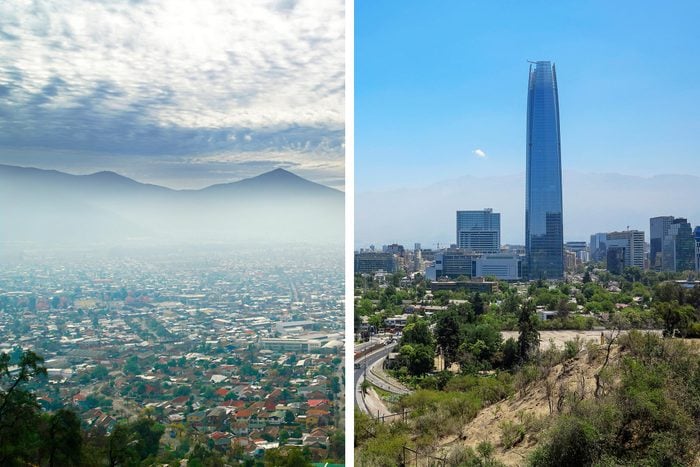
Santiago, Chile
Santiago has long suffered from air pollution. The growing number of cars, industrial activity, and burning wood stoves, especially in the winter months, have contributed to its smoggy conditions. The government had banned certain vehicles, burning wood for heat, and scorching fields to curb air pollution. Now, with coronavirus restrictions in place, the residents of the Chilean capital are finally able to enjoy the beauty of the glacier-capped mountains encircling the city. Air pollution has decreased by a third during the shutdown of large areas of the city to combat coronavirus, according to a report released by the University of Santiago. “The Andes are more clearly visible, the days seem brighter, and the sun seems stronger than is normal for this time of year,” says Eileen Smith, a writer who has been living in Santiago for 16 years. Santiago consistently ranks as a top city in South America for visitors.
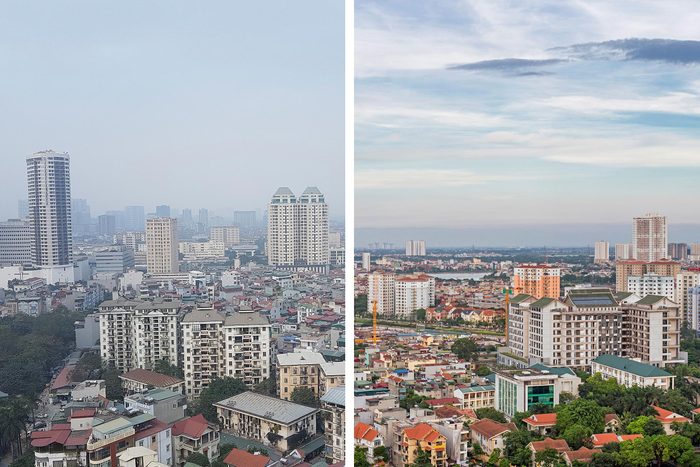
Hanoi, Vietnam
Last year, Hanoi was listed among the most polluted cities on the AirVisual index prompting the government to warn its residents to keep windows closed and not to exercise outdoors. Pollution from burning coal and crop remnant fires on farms are some of the factors contributing to the constant haze that the city endures in the absence of rain.
In early April, the Vietnam Times reported that air quality significantly improved due to COVID-19 measures which reduced transportation by half and halted manufacturing. The bustling capital city of Hanoi, along with Ho Chi Minh City, experienced much cleaner air between late March and April; the PM2.5 level that had stood at 104.3 micrograms/cubic meter, far exceeding WHO’s recommendation, dropped to 11.5 by the end of March.
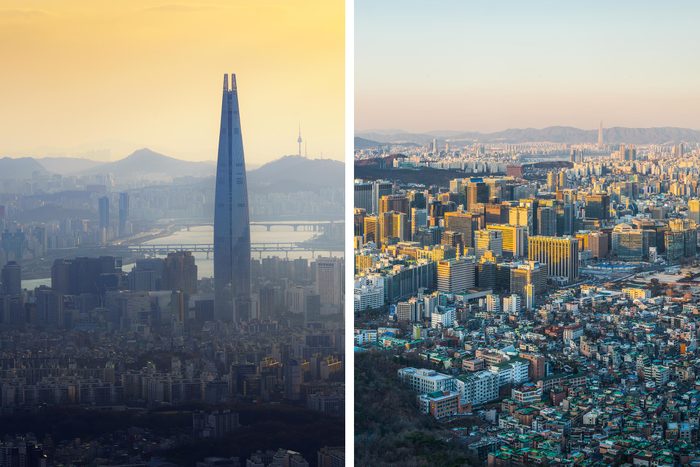
Seoul, South Korea
Last March, South Korea took emergency measures to address the “social disaster” of pollution, after seeing record levels of fine dust layering all across the nation, reported The Guardian. Despite measures to limit the use of vehicles, curb coal-fired power stations, and construction, the city saw little improvement.
Almost a year later in February, the Asian country faced one of the largest coronavirus outbreaks outside of mainland China. According to CNN, the nation brought the cases under control with aggressive testing and contact tracing methods. As an added bonus, the capital of Seoul “saw a 54 percent drop in PM2.5 levels from February 26 to March 18 from the previous year.”
